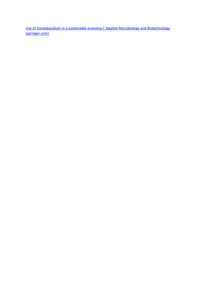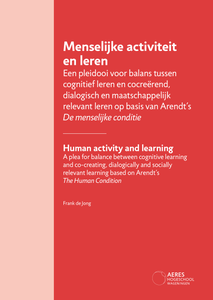Abstract Aureobasidium is omnipresent and can be isolated from air, water bodies, soil, wood, and other plant materials, as well as inorganic materials such as rocks and marble. A total of 32 species of this fungal genus have been identified at the level of DNA, of which Aureobasidium pullulans is best known. Aureobasidium is of interest for a sustainable economy because it can be used to produce a wide variety of compounds, including enzymes, polysaccharides, and biosurfactants. Moreover, it can be used to promote plant growth and protect wood and crops. To this end, Aureobasidium cells adhere to wood or plants by producing extracellular polysaccharides, thereby forming a biofilm. This biofilm provides a sustainable alternative to petrol-based coatings and toxic chemicals. This and the fact that Aureobasidium biofilms have the potential of self-repair make them a potential engineered living material avant la lettre.
MULTIFILE

Boven titel staat vermeld: De symbiose van biologie en technologie. Zowel vanuit het Applied Science onderwijs als vanuit het werkveld kwam er meer vraag om biologische expertise toe te voegen aan het bestaande lectoraat Thin Films & Functional Materials.
DOCUMENT

Systemic sclerosis (SSc) is an autoimmune disease which is characterized by vasculopathy, tissue fibrosis and activation of the innate and adaptive immune system. Clinical features of the disease consists of skin thickening and internal organ involvement. Due to the heterogeneous nature of the disease it is difficult to predict disease progression and complications. Despite the discovery of novel autoantibodies associated with SSc, there is an unmet need for biomarkers for diagnosis, disease progression and response to treatment. To date, the use of single (surrogate) biomarkers for these purposes has been unsuccessful. Combining multiple biomarkers in to predictive panels or ultimately algorithms could be more precise. Given the limited therapeutic options and poor prognosis of many SSc patients, a better understanding of the immune-pathofysiological profiles might aid to an adjusted therapeutic approach. Therefore, we set out to explore immunological fingerprints in various clinically defined forms of SSc. We used multilayer profiling to identify unique immune profiles underlying distinct autoantibody signatures. These immune profiles could fill the unmet need for prognosis and response to therapy in SSc. Here, we present 3 pathophysiological fingerprints in SSc based on the expression of circulating antibodies, vascular markers and immunomodulatory mediators.
DOCUMENT
In een tijd waarin de wereld geconfronteerd wordt met een toenemende bevolking en de daaruit voortvloeiende behoefte aan voedsel, staat het lectoraat Eiwittransitie voor een uiterst relevante uitdaging. De groeiende vraag naar eiwitten en de noodzaak om onze consumptiegewoonten in balans te krijgen met natuur en onze gezondheid vormen de kern van de missie van dit lectoraat.
DOCUMENT

Polymeren, waaronder plastics, kennen we allemaal uit ons dagelijks leven. Van de plastic draagtas tot computeronderdelen en kopjes. Allemaal worden deze polymeren vervaardigd uit aardolie en afgeleide producten. De producten zijn zeer nuttig en breed toepasbaar, mede door de gunstige eigenschappen zoals warmteweerbaarheid, stevigheid en waterdichtheid. Daarentegen kennen polymeren ook een keerzijde, zoals het niet of moeilijk afbreekbaar zijn in de natuurlijke omgeving en de nadelen van het gebruik van fossiele bronnen: hun eindigheid en de ongecontroleerde emissie van broeikasgassen die verband houdt met klimaatverandering. Dit is een zichtbaar probleem bij onder meer De Plasticsoep, waar geen of beperkte afbraak plaatsvindt van plastics in de oceaan. De zoektocht naar alternatieven is daarom volop aan de gang.
DOCUMENT

The agrifood sector is crucial for achieving global food security and environmental sustainability. In the Netherlands, innovations in food technology and adjacent areas are achieved in attractive projects at Universities of Applied Sciences (UASs) in close interaction with government, industry, other knowledge institutes and society. By providing students central positions in innovative joint efforts that answer to the demands of small and medium sized enterprises, the curricula stay up to date and appealing. Examples of such efforts are the Food Innovation Academy (FIA), the World Horti Centre (WHC) and the Food Innovation Community Amsterdam (FICA). Interdisciplinary projects in these settings help to encourage students to choose for a future in agrifood. Exposure is key to reach the target groups. For that reason, several paths on the roadmap of the human capital agenda have to be taken. We developed inspiring learning materials that appeal to students and teachers in secondary schools. A “Genomics Cookbook” to introduce biological knowledge behind nutrigenomics and a velcro-model called “DNAbAND” to explain principles behind the Polymerase Chain Reaction for food safety applications, are examples. These are ways to increase influx into green colleges and universities, and thereby efflux to the agrifood sector.
DOCUMENT

Plasmid-mediated dissemination of antibiotic resistance among fecal Enterobacteriaceae in natural ecosystems may contribute to the persistence of antibiotic resistance genes in anthropogenically impacted environments. Plasmid transfer frequencies measured under laboratory conditions might lead to overestimation of plasmid transfer potential in natural ecosystems. This study assessed differences in the conjugative transfer of an IncP-1 (pKJK5) plasmid to three natural Escherichia coli strains carrying extended-spectrum beta-lactamases, by filter mating. Matings were performed under optimal laboratory conditions (rich LB medium and 37°C) and environmentally relevant temperatures (25, 15 and 9°C) or nutrient regimes mimicking environmental conditions and limitations (synthetic wastewater and soil extract). Under optimal nutrient conditions and temperature, two recipients yielded high transfer frequencies (5 × 10–1) while the conjugation frequency of the third strain was 1000-fold lower. Decreasing mating temperatures to psychrophilic ranges led to lower transfer frequencies, albeit all three strains conjugated under all the tested temperatures. Low nutritive media caused significant decreases in transconjugants (−3 logs for synthetic wastewater; −6 logs for soil extract), where only one of the strains was able to produce detectable transconjugants. Collectively, this study highlights that despite less-than-optimal conditions, fecal organisms may transfer plasmids in the environment, but the transfer of pKJK5 between microorganisms is limited mainly by low nutrient conditions.
DOCUMENT

Closed loop or ‘circular’ production systems known as Circular Economy and Cradle to Cradle represent a unique opportunity to radically revise the currently wasteful system of production. One of the challenges of such systems is that circular products need to be both produced locally with minimum environmental footprint and simultaneously satisfy demand of global consumers. This article presents a literature review that describes the application of circular methodologies to education for sustainability, which has been slow to adopt circular systems to the curriculum. This article discusses how Bachelor and Master-level students apply their understanding of these frameworks to corporate case studies. Two assignment-related case studies are summarized, both of which analyze products that claim to be 'circular'. The students' research shows that the first case, which describes the impact of a hybrid material soda bottle, does not meet circularity criteria. The second case study, which describes products and applications of a mushroom-based material, is more sustainable. However, the students' research shows that the manufacturers have omitted transport from the environmental impact assessment and therefore the mushroom materials may not be as sustainable as the manufacturers claim. As these particular examples showed students how green advertising can be misleading, applying “ideal” circularity principles as part of experiential learning could strengthen the curriculum. Additionally, this article recommends that sustainable business curriculum should also focus on de-growth and steady-state economy, with these radical alternatives to production becoming a central focus of education of responsible citizens. https://doi.org/10.1016/j.jclepro.2019.02.005 LinkedIn: https://www.linkedin.com/in/helenkopnina/
MULTIFILE

Echinoderm mass mortality events shape marine ecosystems by altering the dynamics among major benthic groups. The sea urchin Diadema antillarum, virtually extirpated in the Caribbean in the early 1980s by an unknown cause, recently experienced another mass mortality beginning in January 2022. We investigated the cause of this mass mortality event through combined molecular biological and veterinary pathologic approaches comparing grossly normal and abnormal animals collected from 23 sites, representing locations that were either affected or unaffected at the time of sampling. Here, we report that a scuticociliate most similar to Philaster apodigitiformis was consistently associated with abnormal urchins at affected sites but was absent from unaffected sites. Experimentally challenging naïve urchins with a Philaster culture isolated from an abnormal, field-collected specimen resulted in gross signs consistent with those of the mortality event. The same ciliate was recovered from treated specimens postmortem, thus fulfilling Koch’s postulates for this microorganism. We term this condition D. antillarum scuticociliatosis.
DOCUMENT

Deze afscheidsrede van Frank de Jong verwondert zich over de sterke impact van (directe) instructie in het onderwijs en de daarmee samenhangende gerichtheid op het individuele leren. Om een antwoord te vinden op die verwondering put de rede uit de filosofe Hannah Arendt en haar analyse van de menselijke conditie, de vita activa. Arendt onderscheidt drie menselijke activiteiten: arbeid, werken, spreken en handelen. Arbeid gaat over het voorzien in basisbehoeften en het creëren van een ‘thuis’ met anderen waar het goed toeven is. Werken heeft te maken met het creëren van talen en cultuur en daarmee een kunstmatige wereld. Spreken en handelen omvatten het organiseren van de samenleving en politiek bedrijven. Door het leren en onderwijs te koppelen aan de vita activa komt een beeld naar voren van een onderwijs dat zich voornamelijk richt op arbeid en werken, met een sterke nadruk op (directe) instructie en het aanleren van vaardigheden en kennis. Het spreken en handelen, het ontwikkelen van ideeën en het samenwerken aan een betere wereld, blijven vaak onderbelicht in het onderwijs. Directe instructie mag dan wel efficiënt zijn in het steeds meer geïndustrialiseerde onderwijs met eindtermen en managerial KPI’s, het is niet effectief in het licht van het de totale ontwikkeling als mens. Dit pleit voor meer ruimte te creëren voor idee-ontwikkeling, co-creatie, kennisopbouw en dialoog in het onderwijs. Een onderwijstransitie van een 'belief mode' van leren naar een 'design mode' van leren met de nodige infrastructurele verandering op verschillende niveaus die zo’n transitie vereist. Er is een groeiend bewustwording nodig dat de huidige rol en wijze van leren in het onderwijs en in (school)organisaties onvoldoende bijdraagt aan de oplossingen van de huidige complexe uitdagingen in onze samenleving. Een bredere en diepere benadering van leren in het onderwijs, waarbij niet alleen kennisoverdracht en vaardigheden worden benadrukt, maar ook het ontwikkelen van ideeën, samenwerking en dialoog centraal staan is noodzakelijk, zodat er ruimte is om spreken en handelen te ontwikkelen opdat mensen af en toe uit de rij te stappen om een beter ‘thuis’ te realiseren. Dit doe je niet in je eentje maar in cocreatie met anderen samen en dat moet je (stimu)leren.
DOCUMENT
